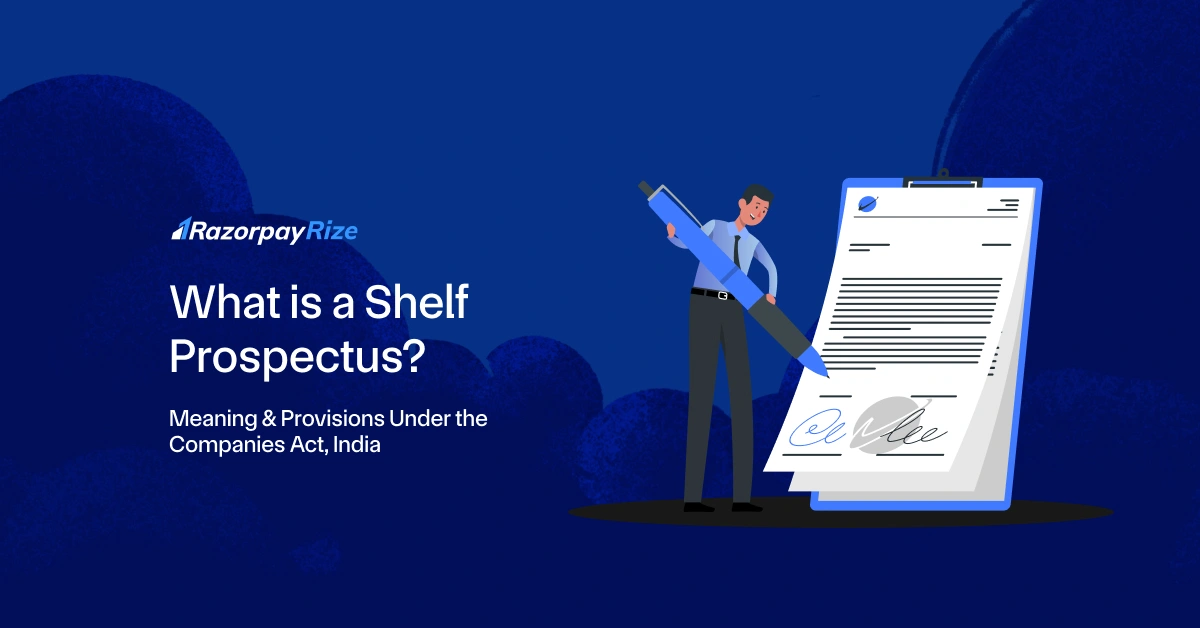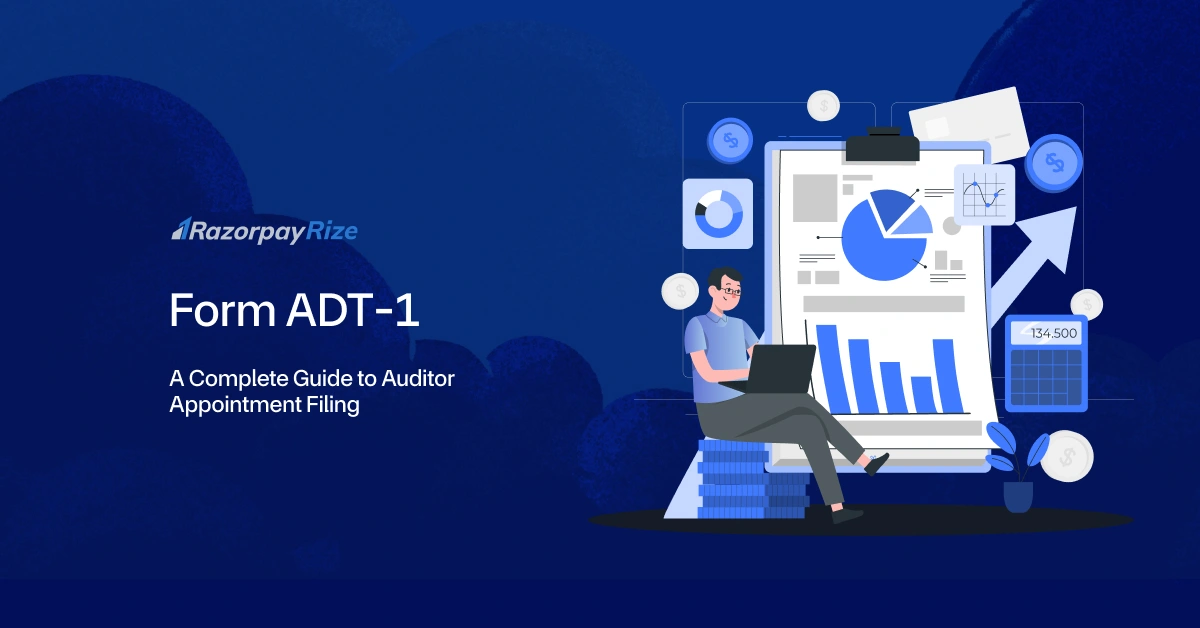A shelf prospectus is a legal document under the Companies Act of 2013 that allows a company to issue multiple rounds of securities without filing a new prospectus for each offering.
Once a company gets approval for a shelf prospectus, it can issue securities in tranches over a period (usually one year) without repeating the regulatory approval process. This mechanism is particularly beneficial for businesses that require frequent access to capital markets.
Simply put, a company gets approval for a prospectus and "shelves" it for use when needed. Just like a store keeps items on a shelf, ready to be picked up when required, companies can tap into their shelf prospectus whenever they decide to issue securities within the approved period.
Table of Contents
Shelf Prospectus Meaning
A shelf prospectus is a document issued by companies intending to offer securities in multiple tranches over a specified period without filing a new prospectus for each offering. Governed by the Companies Act of 2013, it serves as a framework to streamline capital-raising activities while ensuring regulatory compliance.
This approach helps all types of companies save time and resources while maintaining transparency in financial disclosures.
What Is The Validity Period of Shelf Prospectus?
As per the Companies Act of 2013 and SEBI regulations, a shelf prospectus is valid for one year from the issue date. During this period, the company can make multiple security offerings without submitting a fresh prospectus.
However, an Information Memorandum must be filed for each subsequent offering to ensure updated financial and operational disclosures.
What Are The Requirements For Shelf Prospectus?
To issue a shelf prospectus, a company must fulfil specific requirements under the Companies Act, 2013:
- Eligibility Criteria: The company must be a public financial institution, a bank, or a company notified by SEBI.
- SEBI Approval: Approval from the Securities and Exchange Board of India (SEBI) is mandatory before issuance.
- Financial Disclosures: The prospectus must include audited financial statements, business details, and risk factors.
- Regulatory Compliance: The company must adhere to statutory provisions and filing requirements.
Who Can Issue Shelf Prospectus?
Not all companies are eligible to issue a shelf prospectus. As per SEBI regulations, only specific entities can do so, including:
- Public Financial Institutions such as banks and NBFCs.
- Scheduled Banks that meet regulatory criteria.
- Other Companies notified by SEBI, provided they meet compliance standards.
Looking to register your LLP? Head over to Razorpay Rize and get your LLP incorporated today!
What Are The Eligibility Criteria For a Company to Issue a Shelf Prospectus?
To issue a shelf prospectus, a company must meet the following key eligibility criteria:
- Strong Financial Performance: A consistent and positive financial track record is essential.
- Regulatory Compliance: The company must have a history of timely filings and adherence to statutory norms.
- Market Reputation: A credible and trustworthy market presence is necessary.
- Clear Disclosure of Fund Utilization: The company must provide transparency regarding how the raised funds will be used.
5 Incredible Advantages of Shelf Prospectus
A shelf prospectus offers several benefits to companies and investors:
- Flexibility: Companies can issue securities as needed without additional regulatory approvals.
- Cost Efficiency: Reduces administrative and compliance costs associated with repeated filings.
- Faster Time to Market: Companies can respond quickly to market conditions.
- Improved Investor Relations: Provides transparency and trust through consistent financial disclosures.
- Strategic Financial Planning: Enables better capital-raising strategies over time.
How Does an Investor Benefit from a Shelf Prospectus?
Investors gain multiple advantages from a shelf prospectus:
- Greater Transparency: A single document offers comprehensive details about the company.
- Consistent Access to Securities: Investors can participate in multiple offerings from a single prospectus.
- Time-Saving: Reduces the need to analyse multiple prospectuses for each security issuance.
- Better Investment Planning: Enables informed decision-making with consistent financial disclosures.
Difference Between Shelf Prospectus and Red Herring Prospectus?
Financial Securities and Shelf Prospectus
A shelf prospectus allows companies to issue various types of financial securities, including:
- Equity Shares: Ownership stakes in a company.
- Debentures: Debt instruments issued by companies.
- Bonds: Fixed-income securities providing periodic interest payments.
This streamlined approach reduces delays and administrative hurdles for issuing these securities over multiple tranches.
What Is an Information Memorandum?
An Information Memorandum is a document containing essential details about a company’s financials, operations, and business strategy. It is a key resource for investors, offering in-depth insights into the company's capital-raising plans.
When a company issues securities under a shelf prospectus, it must file an Information Memorandum before each offering to ensure updated and accurate disclosures.
Procedure to Fill Form PAS-2
Form PAS-2 is required to be filed as per the Companies (Prospectus and Allotment of Securities) Rules, 2014. Here’s how to fill it:
- Company Details: Enter the name, registered office, and CIN.
- Security Details: Specify the type and number of securities being offered.
- Offer Details: Mention the issue price, purpose, and utilisation of funds.
- Financial Statements: Attach recent audited financial reports.
- Declaration: Ensure proper authorisation and sign the form.
Procedure to Upload Form PAS-2
Once Form PAS-2 is completed, follow these steps to upload it to the MCA (Ministry of Corporate Affairs) portal:
- Prepare the Form: Ensure all required fields are filled out correctly and attach the necessary documents.
- Log in to the MCA Portal: Use company credentials to access the e-filing section.
- Upload the Form: Select Form PAS-2, attach supporting documents and verify details.
- Payment of Fees: Pay the prescribed filing fee through the portal.
- Submit and Confirm: After submission, a confirmation receipt and acknowledgement are generated.
Conclusion
For companies, a shelf prospectus eliminates the repetitive, time-consuming regulatory hurdles that come with multiple capital raises.
Instead of drafting and filing a new prospectus each time, businesses can plan their fundraising strategically, issuing securities when market conditions are favourable. This saves time, reduces administrative costs, and provides the flexibility needed to stay competitive.
For businesses, this means less paperwork, faster fundraising, and more flexibility to raise funds when needed. For investors, it provides greater transparency and clarity, helping them make better financial decisions.
By using a shelf prospectus wisely, companies can focus on growth, and investors can confidently explore opportunities—making it a win-win for everyone in the financial market.
Frequently Asked Questions
Private Limited Company
(Pvt. Ltd.)
- Service-based businesses
- Businesses looking to issue shares
- Businesses seeking investment through equity-based funding
Limited Liability Partnership
(LLP)
- Professional services
- Firms seeking any capital contribution from Partners
- Firms sharing resources with limited liability
One Person Company
(OPC)
- Freelancers, Small-scale businesses
- Businesses looking for minimal compliance
- Businesses looking for single-ownership
Private Limited Company
(Pvt. Ltd.)
- Service-based businesses
- Businesses looking to issue shares
- Businesses seeking investment through equity-based funding
One Person Company
(OPC)
- Freelancers, Small-scale businesses
- Businesses looking for minimal compliance
- Businesses looking for single-ownership
Private Limited Company
(Pvt. Ltd.)
- Service-based businesses
- Businesses looking to issue shares
- Businesses seeking investment through equity-based funding
Limited Liability Partnership
(LLP)
- Professional services
- Firms seeking any capital contribution from Partners
- Firms sharing resources with limited liability
Frequently Asked Questions
What is meant by Shelf Prospectus?
A Shelf Prospectus is a type of prospectus that allows a company to issue securities in multiple tranches over a period of time without needing to file a separate prospectus for each offering. It provides flexibility for companies to raise funds as needed, reducing administrative burdens and costs.
What is Shelf Prospectus in Company Law Section 1?
In the context of Company Law (India - Companies Act, 2013, Section 31), a Shelf Prospectus is a prospectus issued by public financial institutions, banks, or listed companies for raising capital through multiple offerings. The prospectus remains valid for a specified period, and the company only needs to file an Information Memorandum before each tranche of issuance.
Does the Shelf Prospectus Require a Different Prospectus for Each Offering?
No, a Shelf Prospectus eliminates the need to file a separate prospectus for each offering. Instead, an Information Memorandum is submitted before each issuance, updating investors with relevant details about the specific tranche.
Is Shelf Prospectus Valid for Years?
In India, a Shelf Prospectus is typically valid for one year from the date of filing). Within this period, the company can issue securities in multiple tranches without filing a fresh prospectus each time.
Why Would a Company File a Base Shelf Prospectus?
A company files a Base Shelf Prospectus to:
- Streamline Fundraising: Raise capital efficiently over time without repetitive regulatory approvals.
- Reduce Costs: Minimize administrative and legal expenses associated with frequent filings.
- Enhance Flexibility: Issue securities when market conditions are favourable.
- Ensure Compliance: Maintain transparency while avoiding delays in capital raising.







.webp)








